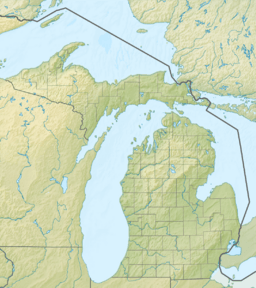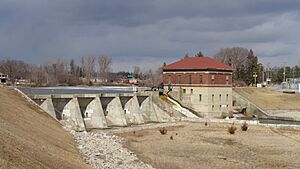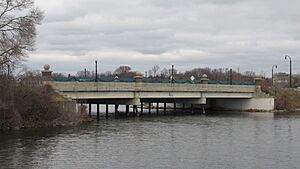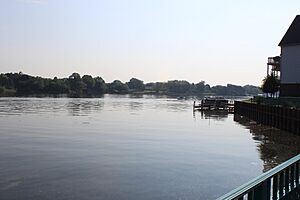Belleville Lake (Michigan) facts for kids
Quick facts for kids Belleville Lake |
|
|---|---|
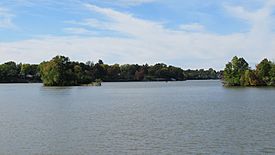
View from Horizon Park in Belleville
|
|
| Location | Washtenaw and Wayne County, Michigan |
| Coordinates | 42°12′43″N 83°29′47″W / 42.21194°N 83.49639°W |
| Type | Fresh water |
| River sources | Huron River |
| Basin countries | United States |
| First flooded | 1925 |
| Surface area | 1,270 acres (5.1 km2) |
| Max. depth | 30 feet (9.1 m) |
| Surface elevation | 650 feet (200 m) |
| Islands | 3 (unnamed) |
| Settlements | Belleville Van Buren Township Ypsilanti Township |
Belleville Lake is a large, man-made fresh water lake in Michigan, USA. Most of the lake is in Wayne County, with a small part reaching into Washtenaw County. The lake was created in 1925 when the French Landing Dam and Powerhouse was built on the Huron River.
Contents
History of Belleville Lake
Belleville Lake is a man-made lake. It was formed in 1925 by the French Landing Dam and Powerhouse, which uses water to make electricity. The lake was first called Edison Lake. This was because the Detroit Edison Company built the dam.
When the lake was made, it covered the small community of Rawsonville. There are no buildings left from that old town. You can only see a historic marker where the community used to be. The dam and a nearby house are also listed as historic sites.
The Belleville Bridge
The first Belleville Bridge was built in 1925. It helped people cross the new lake. This bridge was important for people to reach main roads like U.S. Route 12 and Interstate 94.
In 1985, the area grew, and a bigger road was needed. The old bridge was taken apart and moved to another county. A new, larger bridge was built in its place.
Fish Incidents in 1973
In May 1973, many fish in Belleville Lake died by accident. A special liquid was used in Ford Lake to help new fish grow. But this liquid accidentally flowed into Belleville Lake. This caused a large number of fish to die. Because of this, the state temporarily stopped using that liquid.
Later in September 1973, there was a plan to lower the lake's water level. This was to help control the number of common carp, which were growing too much. The lake was drained by about one-third. But then, some bridges cracked, and a gas line broke because the ground shifted. So, the lake was not drained any further.
The shallower parts of the lake dried up completely. This showed old trash, cars, and even a historic road from 1904. After a short break, the plan to control the carp continued. A helicopter was used to drop the special liquid. This led to a huge cleanup of dead fish, mostly carp. After the bridges were fixed, the lake was refilled and stocked with more native fish.
Geography of Belleville Lake
Belleville Lake is a long lake that stretches about 8 miles (12.9 km) through Van Buren Township. The lake covers an area of 1,270 acres (5.14 km2). It sits 650 feet (200 m) above sea level. The lake mostly follows the path of the Huron River, which flows into and out of it.
The deepest part of the lake is about 30 feet (9.1 m) near its eastern end. The western end is much shallower. Belleville Lake is just downstream from Ford Lake. These two lakes are separated by a short stretch of the Huron River.
The city of Belleville is located along the southern side of the lake. A very small part of the lake also extends into Ypsilanti Township to the west.
Activities on Belleville Lake
Belleville Lake is a popular spot for fun activities. People enjoy boating, using personal watercraft, canoeing, kayaking, and fishing. There are several parks along the lake, including Doane's Landing and Horizon Park.
The Michigan Department of Natural Resources has two public places where you can launch boats. One is on Rawsonville Road, and the other is on East Huron River Drive.
Fishing in Belleville Lake
Belleville Lake is a very popular place to fish. You can find many types of fish here, such as bluegill, catfish, common carp, black crappie, largemouth and smallmouth bass, muskellunge, northern pike, walleye, and yellow perch. Many of these fish are regularly added to the lake by the Michigan Department of Natural Resources.
The lake also has an invasive fish called the round goby. These fish are now part of the lake's environment. Smaller fish like emerald shiner and spottail shiner are also often caught. Bluegill make up a large portion of the fish caught in the lake.
Some very large fish have been caught in Belleville Lake. These include a common carp that was over 36.50 inches (92.71 cm) long. A channel catfish over 33.25 inches (84.46 cm) and a largemouth bass over 25.75 inches (65.41 cm) have also been caught.
Health Information
Sometimes, in late summer, Belleville Lake can have algal blooms. These are like thick green patches on the water. The Michigan Department of Health and Human Services checks the water quality. They warn people if there are too many bacteria that could be harmful.
Most of these blooms are harmless green algae. But sometimes, harmful bacteria can grow. If this happens, it's best not to have long contact with the water. Even so, swimming is not a common activity on the lake.
If the algae levels are too high and could be a problem, a "Do Not Eat" fish warning is put up. This means you can still boat and fish, but you should catch and release the fish.


